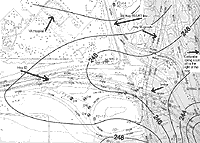On the 26th of September at the Minnehaha Creek Watershed District meeting, will be a discussion of the upcomming 55/62 interchange design, and its affect on Coldwater.
There are two important concepts with the redesign. First is the obvious, dewatering. The more that is dewatered from the interchange, the more it will affect Coldwater Spring flow. In the past, when MnDOT dewatered 90 to 250 gallons per minute constantly at the interchange, from July to December 2001, the spring flow decreased about 30 gallons per minute. The liner concept and raised drains are supposed to help eliminate dewatering as much as possible. However the final numbers wont be known until MnDOT presents the plans, but it can be no more than 30gpm max.
The second major concept is water table height. Below is the contours of the water table before MnDOT construction. Notice that the water table height increases as you move westward to the left of the map. Coldwater Spring is a gravity feed spring. The Spring is to the right of the map.
This downward gradient is necessary for proper
flow and water
pressure for the spring.
If you look at the photograph, you will see that the trench that was dug to allow Hwy 62 to go under the bridge has artificially lowered the water table to the west of the bridge to match the correct height to the east of the bridge.
When construction is complete there should be no exposed water. The pond heights have been raised out of the water table. However when MnDOT constructs the roadbed it will be necessary to do it so that the ground water will be restored to it's original heights.
This means that the roadbed must not allow water to pass though it too easily so that the height difference is restored, and the "natural" water pressure along with it.
Currently the Spring flow is about 10 to 15 gallons per minute lower that it was two years ago. That's a very bad sign given the wet summer. So how the interchange is designed will have a significant impact. Minnehaha Creek Watershed District and MnDOT are still bound by the July 2001 stipulation.
While building this interchange, MnDOT will be above the bedrock. Thanks to the help of many people, the bedrock has been protected (the one thing that absolutely cannot be fixed)! Now they are only in the dirt layers.
When MnDOT presents their plans it must be approved
by the
watersheds, and when it is presented many more questions can be answered
and discussed.

